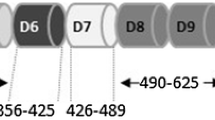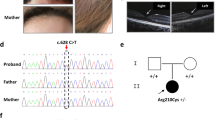Abstract
Ichthyosis Follicularis, Atrichia, and Photophobia (IFAP) is a severe rare genetic disorder caused by mutations in the gene encoding the Membrane-Bound Transcription Factor Peptidase, Site 2 (MBTPS2). Olmsted syndrome is another rare genetic disease with overlapping clinical features caused by mutations in the gene encoding the Transient Receptor Potential Cation Channel, subfamily V (TRPV3). Mutations in MBTPS2 have been recently reported in Olmsted syndrome, underscoring the overlap and the confusion in separating Olmsted from IFAP syndrome. We studied a Lebanese family with IFAP syndrome both, clinically and molecularly, and investigated whether there is a cross relation between TRPV3 and MBTPS2. We identified a recurrent mutation designated p.F475S in MBTPS2 in the affected individuals. This mutation was not found in 100 control individuals from the same population. We determined that TRPV3 regulatory region is a target for MBTPS2. In addition, there was an increased cell death in the cells transfected with the mutant versus the wild-type MBTPS2. In conclusion, we identified a direct regulatory effect of MBTPS2 on TRPV3 which can partially contribute to the overlapping clinical features of IFAP and Olmsted syndromes under a common signaling pathway.




Similar content being viewed by others
References
Alves LU, Pardono E, Otto PA, Mingroni Netto RC (2015) A novel c.1037C > G (p.Ala346Gly) mutation in TP63 as cause of the ectrodactyly-ectodermal dysplasia and cleft lip/palate (EEC) syndrome. Genet Mol Biol 38:37
Aten E, Brasz LC, Bornholdt D, Hooijkaas IB, Porteous ME, Sybert VP, Vermeer MH, Vossen RH, van der Wielen MJ, Bakker E, Breuning MH, Grzeschik KH, Oosterwijk JC, den Dunnen JT (2010) Keratosis follicularis spinulosa decalvans is caused by mutations in MBTPS2. Hum Mutat 31:1125
Bukharia A, Komal S, Sudhanan VM, Chaudhary SS (2016) Olmsted syndrome: rare occurrence in four siblings. Indian J Dermatol 61(3):347
Caserta TM, Kommagani R, Yuan Z, Robbins DJ, Mercer CA, Kadakia MP (2006) p63 overexpression induces the expression of Sonic Hedgehog. Mol Cancer Res 4:759
Duijf PH, van Bokhoven H, Brunner HG (2003) Pathogenesis of split-hand/split-foot malformation. Hum Mol Genet 12(1):R51
Enriquez A, Krivanek M, Flottmann R, Peters H, Wilson M (2016) Recurrence of split hand/foot malformation, cleft lip/palate, and severe urogenital abnormalities due to germline mosaicism for TP63 mutation. Am J Med Genet A 170:2372
Eytan O, Fuchs-Telem D, Mevorach B, Indelman M, Bergman R, Sarig O, Goldberg I, Adir N, Sprecher E (2014) Olmsted syndrome caused by a homozygous recessive mutation in TRPV3. J Invest Dermatol 134:1752
Irvine AD, McLean WH (2003) The molecular genetics of the genodermatoses: progress to date and future directions. Br J Dermatol 148:1
Lin Z, Chen Q, Lee M, Cao X, Zhang J, Ma D, Chen L, Hu X, Wang H, Wang X, Zhang P, Liu X, Guan L, Tang Y, Yang H, Tu P, Bu D, Zhu X, Wang K, Li R, Yang Y (2012) Exome sequencing reveals mutations in TRPV3 as a cause of Olmsted syndrome. Am J Hum Genet 90:558
Megarbane H, Megarbane A (2011) Ichthyosis follicularis, alopecia, and photophobia (IFAP) syndrome. Orphanet J Rare Dis 6:29
Megarbane H, Zablit C, Waked N, Lefranc G, Tomb R, Megarbane A (2004) Ichthyosis follicularis, alopecia, and photophobia (IFAP) syndrome: report of a new family with additional features and review. Am J Med Genet A 124:323
Oeffner F, Fischer G, Happle R, Konig A, Betz RC, Bornholdt D, Neidel U, Boente Mdel C, Redler S, Romero-Gomez J, Salhi A, Vera-Casano A, Weirich C, Grzeschik KH (2009) IFAP syndrome is caused by deficiency in MBTPS2, an intramembrane zinc metalloprotease essential for cholesterol homeostasis and ER stress response. Am J Hum Genet 84:459
Saral S, Vural A, Wollenberg A, Ruzicka T (2017) A practical approach to ichthyoses with systemic manifestations. Clin Genet 91:799
Wang HJ, Tang ZL, Lin ZM, Dai LL, Chen Q, Yang Y (2014) Recurrent splice-site mutation in MBTPS2 underlying IFAP syndrome with Olmsted syndrome-like features in a Chinese patient. Clin Exp Dermatol 39:158
Yoh K, Prywes R (2015) Pathway regulation of p63, a director of epithelial cell fate. Front Endocrinol (Lausanne) 6:51
Acknowledgements
We would like to thank the family members for agreeing to participate in the study. We like to thank Dr. Mirvat Sibai for providing us with the ER marker and Ms. Inaam El Rassi for the technical support. This work was funded by MPP and URB grants to Mazen kurban from the American University of Beirut and a grant from the Lebanese National Council for Scientific Research.
Author information
Authors and Affiliations
Corresponding author
Ethics declarations
Conflict of interest
The authors declare that they have no conflict of interest.
Funding
This study was funded by MPP and URB grants to Mazen kurban from the American University of Beirut and a grant from the Lebanese National Council for Scientific Research.
Ethical approval
All procedures performed in studies involving human participants were in accordance with the ethical standards of the institutional and/or national research committee and with the 1964 Helsinki declaration and its later amendments or comparable ethical standards.
Informed consent
Informed consent was obtained from all individual participants included in the study.
Rights and permissions
About this article
Cite this article
Nemer, G., Safi, R., Kreidieh, F. et al. Understanding the phenotypic similarities between IFAP and Olmsted syndrome from a molecular perspective: the interaction of MBTPS2 and TRPV3. Arch Dermatol Res 309, 637–643 (2017). https://doi.org/10.1007/s00403-017-1762-z
Received:
Revised:
Accepted:
Published:
Issue Date:
DOI: https://doi.org/10.1007/s00403-017-1762-z




